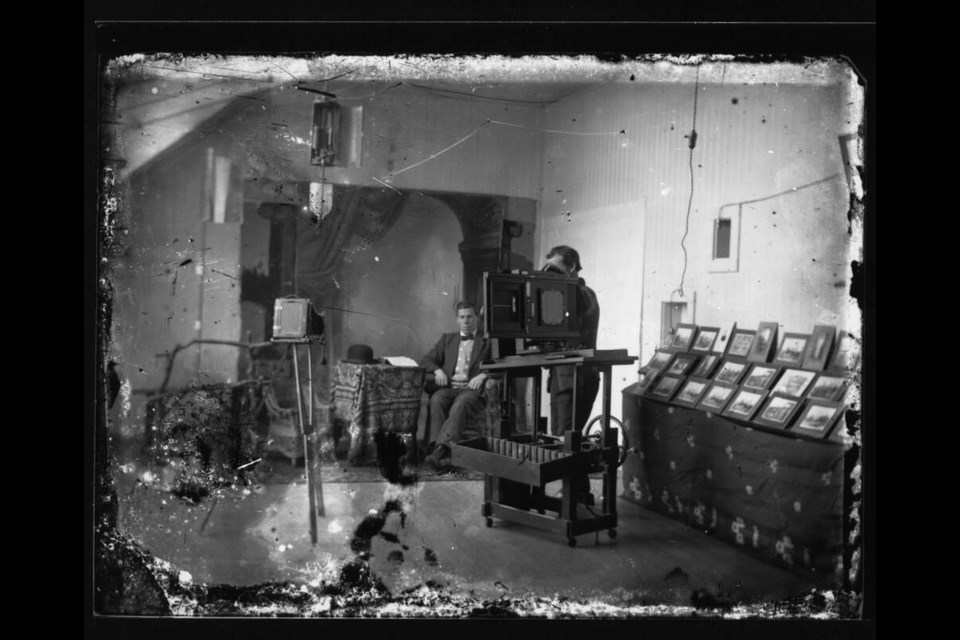Guided by a faded, tattered photograph, the Royal British Columbia Museum has built a replica of a small studio in Cumberland from a century ago that chronicled the lives and important roles of Japanese Canadians in the Vancouver Island mining town and surrounding region.
The Hayashi Photography Studio operated for 30 years and through hundreds of photographs made from glass negatives showed how the immigrant community settled the region and integrated into Canadian life — working in the coal mines, playing baseball, taking family portraits and joining schools and community organizations.
The display is part of the redesign of the museum’s Old Town, New Approach exhibit and is a collaboration with the Hayashi, Matsubuchi and other Japanese families of Cumberland, the Cumberland Museum and Archives, Landscapes of Injustice: Past Wrongs, Future Choices, and the Nikkei National Museum & Cultural Centre.
The exhibit showcases the studio’s significant role in documenting the diverse community of Cumberland from 1912 to 1942.
Senjiro Hayashi founded Hayashi Studio and it was later operated by other Japanese Canadian photographers, including Tokitaro Matsubuchi.
Over the decades, the studio became an integral part of the community and its history, including a photograph of the funeral procession of labour activist Ginger Goodwin in Cumberland in 1918.
The photography studio closed in 1942 amid growing discrimination and the internment of Japanese Canadians during the Second World War.
Sadly, the final photographs from the studio were commissioned by the Canadian government to create identification cards for the local Japanese Canadian community as part of their internment and forced relocation into camps.
“It is encouraging to see this important and little-known slice of Japanese Canadian history brought to life for new audiences,” said Sherri Shinobu Kajiwara, director and curator of the Burnaby-based Nikkei National Museum & Cultural Centre.
She credits the centre’s inaugural director and curator, Grace Eiko Thomson, “who is no longer with us to see new inspiration from her work on Japanese Canadian photo studios from over two decades ago.”
Eiko Thomson, who was also president of the National Association of Japanese Canadians, died last July at age 90 and played a key role in the Hayashi Studio research.
Descendants of Hayashi said in a statement they are honoured to have Senjiro Hayashi’s studio set up the the provincial museum.
“Senjiro’s photography, along with the invaluable contributions of Mr. Kitamura and Tokitaro Matsubuchi, who later took over the studio, offers a unique and intimate glimpse into the lives of the people of Cumberland and Royston at the turn of the 20th century,” the family said.
“Through their lenses, we are privileged to witness the stories of early immigrant communities in the Comox Valley — a narrative that resonates with the broader contributions of minority communities to the growth and development of British Columbia as a whole.”
The Hayashi family extended “heartfelt thanks” to the Cumberland Museum and Archives and the staff and volunteers for their dedication to preserving the work and to the Royal B.C. Museum for showcasing the studio “as one of the many stories that have shaped our province.”
Rosslyn Shipp, former executive director of the Cumberland Museum and Archives, said the new display is an opportunity to celebrate an artist and community member who played an important role in shaping Cumberland.
“[It’s] an exciting occasion, celebrating the artistry and vision of Senjiro Hayashi, a true leader within the Cumberland community,” said Shipp. “At the turn of the century, Hayashi used photography as a powerful medium of creative expression, capturing the vibrant diversity of Cumberland’s people. His work and those who took up the practice after him offer us a unique glimpse into a pivotal era in our shared history, preserving stories that continue to inspire and connect us across generations.”
The Royal British Columbia Museum said the Hayashi Photography Studio will continue to evolve over time, with new interactive elements introduced to enhance visitors’ experiences.
One of the highlights in the first year of the display is the 25-minute documentary Hayashi Studio, directed by Hayley Gray and Elad Tzadok, which is being shown in the Majestic Theatre in Old Town. The documentary, which features interviews with the great grandson and granddaughter of Hayashi, is an in-depth look at the Hayashi Photography Studio.
The display is on the mezzanine level of the Grand Hotel in Old Town.
>>> To comment on this article, write a letter to the editor: [email protected]




